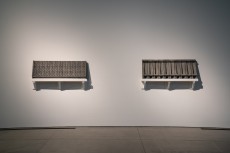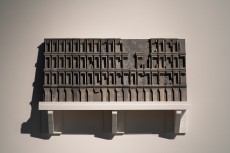
Dynamic Garden in Full Motion
Saturday, July 28th until Sunday, September 9th, 2018
Sahil NAIK
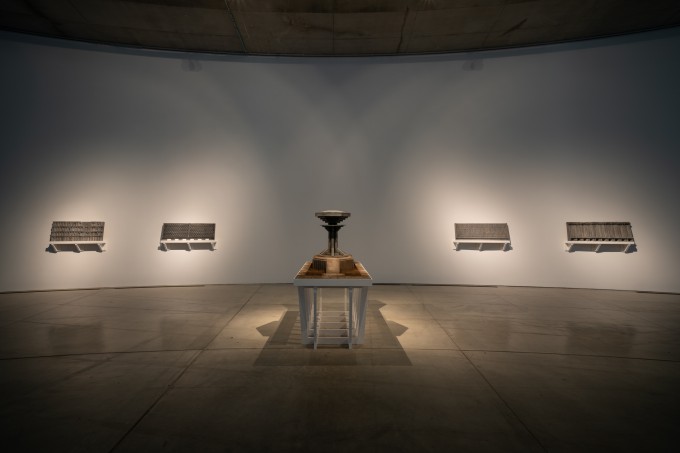
Monument, Mausoleum, Memorial, Modernism
Photo: KATO Ken
What Creations Liberation Hath Wrought
MURAKAMI Aya
An artwork can sometimes tell more than its creator intends. And Sahil NAIK is no exception. His artwork possessed more meaning than even he could have imagined.
Naik is interested in architecture that is open to speculative narratives and capable of evoking human memories. During his residency at the ACAC, he came into contact with the architecture of ANDO Tadao and through research later discovered the work of TANGE Kenzo, turning his gaze toward the role of architecture in Japan after World War II.
His resident work, titled Monument, Mausoleum, Memory, Modernism, was installed with its back to the large, curving arc of the gallery wall. Located in the center of his exhibit was a nail-like structure with a staircase at its base, flanked on both sides by a total of four reliefs that clung to the gallery wall. Naik conceived his central sculpture from the modernist movement that followed the Second World War, while the geometric patterns visible on the reliefs that hung from the gallery wall were inspired by the facades of modern architecture. To apply the finishing touches to their surface, Naik referenced the aesthetics of brutalist architecture, characterized by its honest, raw construction materials—mainly concrete—left ruggedly exposed.
Examples of these kinds of concrete, geometrically patterned buildings can be found all over Japan today. Monument, Mausoleum, Memory, Modernism has a monument at its center and is surrounded by modern architecture, bearing a striking resemblance to many sights we encounter in Japanese cities today. The Genbaku Dome at the Hiroshima Peace Memorial is a monument in and of itself, simultaneously a testament to the existence of both aggressor and victim. Similarly, Monument, Mausoleum, Memory, Modernism illustrates that buildings in historical places are both monuments and mausoleums, eyewitnesses to an era of modernization. Sturdy as it may appear, several cracks are visible in the repeated concrete patterns that hang from the wall, as if to point out the fragility of our modern order despite its resilient appearance. The round, lid-like shape that caps Naik’s central sculpture brings to mind an atomic mushroom cloud. Naik had originally intended to leave the top of his monument open and hollow inside, similar to a cooling tower seen at nuclear power plants, so viewers could peer in from above.
Here I should highlight the fact that sculptures originally existed as memorials. For Naik, there is no difference between sculpture and architecture, and he works with sculpture as a means to express his interests.(*1) I am forced to ask myself: what meanings can a discussion of the monumentality of architecture have through the medium of sculpture, which has long been used to create monuments?
Naik chose concrete as his primary material. Unassuming and functional, concrete has been an instrumental material in modern architecture. However, concrete expert Professor Adrian Forty points out the paradoxical duality of concrete as both modern and non-modern. Western architects of the twentieth-century fell in love with concrete for its simple, even primitive, method of production that resembles that of mud walls. They aimed to created massive structures, which gave rise to its non-modern nature. (*2) Moreover, the non-modern concrete architecture of Tange Kenzo, whose excessive use of beams mimicked traditional Japanese architecture, provoked Western architects to think about concrete as a primitive material, exacerbating this duality. Additionally, many monuments were saved from going out of style as concrete was seen as a tougher and more modern replacement for stone. Artists, on the other hand, have used concrete for a durable, seamless finish, but it has been treated as a peripheral material.(*3) Regarded by architects as a mass that retains the flaws of the workers—in other words, a sculptural material—concrete fell into disuse by artists, though it still proved useful when building monuments for its durability and newer impression. For imaginative contemporary sculptures, it may be inconvenient to recall the architectural functionality of concrete or its monumental symbolism. The material is too loaded with associations to the symbolism and functionality reminiscent of religious architecture and sculpture.
But to Naik, these associations do not exist. He sees no barriers between sculpture and architecture. As seen in the the documentation of his artwork, there is little difference between sculpture and architecture in terms of shape, and perhaps historical context is the only thing differentiating one from the other. And so Naik, meandering between fields and implications, points out the monumentality of architecture using sculptures of concrete, unexpectedly highlighting the instability of these very frameworks.
(*1)Naik, Sahil. Personal interview. August 26, 2018. AC2. No. 20, Aomori Contemporary Art Centre, 2018.
(*2)Forty, Adrian. Concrete and Culture - a Material History. London: Reaktion Books, 2016, p. 13-41.
(*3) Ibid. p.197-223.
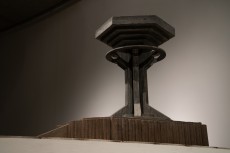


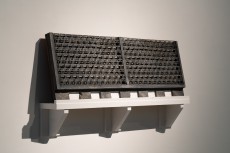
未完の庭、満ちる動き
2018年7月28日(土)-9月9日(日)10:00 18:00、会期中無休、無料
サヒル・ナイク
Sahil NAIK

《モニュメント、霊廟、記憶、モダニズム》
撮影:加藤健
しがらみの無さが生むもの
村上 綾
作品は時に作者の予想を超えて語る。サヒル・ナイクの作品も彼自身が想像した以上の意味を孕みながら存在していた。
ナイクは人々の記憶や推測を引き出す建築物に関心を持って制作してきた。ACACでの今回の滞在で安藤忠雄設計の建築に触れ、リサーチによって丹下健三にたどり着き、自身の関心を第二次世界大戦以後の建築の役割に向けた。
《モニュメント、霊廟、記憶、モダニズム》はギャラリーの大きな方の円弧の壁面を背にして設置された。中央には釘のような造形物の基部に階段がついた立体部分が置かれ、それを左右から2つずつ挟むようにしてレリーフ状の部分が壁付けで設置された。中央に配置された彫刻の形は第二次世界大戦以後のモダニズム建築から発想され、大きな円弧の壁際に設置された部分に表された幾何学模様もモダニズム建築の正面(ファザード)部分のパターンから想を得て制作したものだった。表面の仕上げにおいても参照したのは、コンクリートを素材の中心に、打ち放しといった荒い仕上げを特徴として直接的でかつ生の素材を使用するというブルータリズムの理念だった。
コンクリートで幾何学的なパターンが使用された建築は現在の日本でも至る所で確認することが出来る。《モニュメント、霊廟、記憶、モダニズム》において、中央には記念碑、その周りには近代建築という現代の私たちが目にする状況とほぼ同じことが表されている。広島の原爆ドームの姿は記念碑そのものであり、出来事には同時に加害者と被害者が存在していたことを証言するように《モニュメント、霊廟、記憶、モダニズム》は、歴史的な場に存在した建物は、記念碑かつ霊廟でもあり、近代化の目撃者でもあることを示している。コンクリートは堅牢な姿を見せながらも、壁際に設置された部分の繰り返されるパターンの中に見られるいくつかの亀裂は私たちの強固に見える現代社会の脆さを明らかに指摘している。中央の彫刻の上部には丸みのある蓋のような部分があり原爆のきのこ雲も想起させ、実現は叶わなかったが、その上部を塞がず上からのぞいた内側の形を原子炉を上空からのぞいた際に見える形を参考に作るという構想もあったことを考えれば、それは明白である。
ただここで、彫刻が本来的に記念碑的な存在として扱われてきたことを思い起こしてみたい。ナイクにとって彫刻と建築の差異はなく、自身の関心を基に表現し純粋に彫刻を制作方法として扱う(*1)が、ここで私は考えざるを得ない。記念碑としての役割も担ってきた彫刻という方法で、建築の記念碑性について語ることは、どのような意味合いを持ちうるだろうか?
彼が使用したコンクリートという素材は、機能性と非装飾を進めた近代建築の立役者である。しかし、エイドリアン・フォーティーは『メディアとしてのコンクリート』において、コンクリートの近代と非近代の二重性を指摘する。コンクリートの工程の土に似た単純かつ原初的な方法に惚れ込んだ20世紀初めの西洋の建築家たちが量塊的な構造を志向し、その非近代の性質を生んだという。さらに、ナイクが参照した丹下の日本の伝統建築のごとく過剰な梁を用いた非近代的な建築は、西洋の建築家たちを原始的な扱いへと駆り立て、この二重性を推し進めた(*2)。また、モニュメントはコンクリートによって石に代わる耐久性とモダンの趣を得て、時代遅れの状況から救われた一方で、芸術家はコンクリートを耐久性や継ぎ目なしの仕上げのために使用したが、どちらかと言えば周縁的な素材として扱ってきた(*3)。建築家によって手の痕跡のある量塊、つまり彫刻的な素材として扱われたコンクリートは、耐久性と新しい印象付けとしてモニュメントに重宝されながらも、芸術家の手からは離れていった。見る側に想像力を提供する現代彫刻にとって、建築の機能性やモニュメントの象徴性を思い起こされることは不都合であったと言えるだろう。コンクリートには、宗教建築や偶像から自律してきた近代以降の彫刻として避けるべきしがらみが多すぎたのだ。
ただ、ナイクにとってこのしがらみは存在せず、彫刻と建築を垣根なく捉えている。作品を接写した記録写真からも分かるように、形の上では彫刻と建築の違いは確かに希薄で、歴史の文脈で互いの役割が分化しただけなのかもしれないと思える。このようにナイクは、分野や意味合いの中をさまよってきたコンクリートを用いた彫刻という方法によって建築の記念碑性を指摘し、彫刻や建築という枠組みの不安定さを図らずもつまびらかにしたのである。
(*1)インタビュー(2018年8月26日)での発言より。『AC2』20号、国際芸術センター青森、2018年
(*2)エイドリアン・フォーティー著『メディアとしてのコンクリート 土・政治・記憶・労働・写真』坂牛卓ほか訳、鹿島出版会、2016年、p.11-45,
(*3)同書p.251-282

